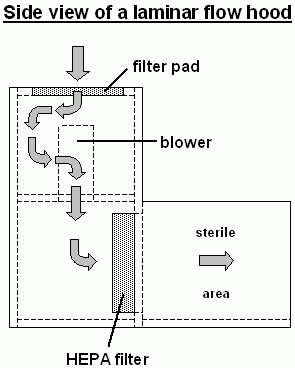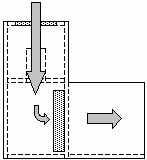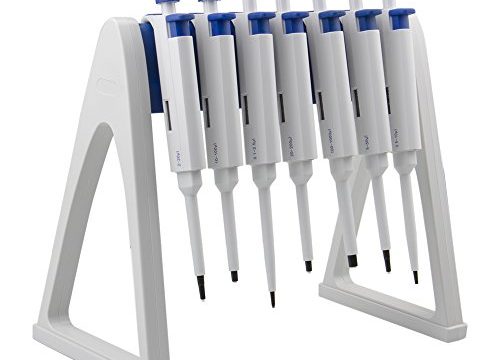To carry out some specialized experiments or work many laboratories including, medical, pharmaceutical, environmental, biotechnological, and few electronic labs need sterile, dust-free areas. In such places, the laminar air flow system is used to make the entire working area contamination or particle free.
Laminar Air flow system can be defined as a system that offers continuous air flow which is uniform in both direction and velocity. Laminar Air Flow Hoods or Cabinets provide unidirectional air flow in a limited designated space. They make the particulate-free working area by blowing out air through a filtration system and exhausting it across the work surface.
What is a Laminar Flow Cabinet?
Laminar Air Flow Cabinets are enclosures designed to flow HEPA filtered air with uniform velocity and direction. This unidirectional airflow helps to maintain sterility and prevents cross-contamination.
How Laminar Air Flow cabinets are made?
Laminar Air Flow Cabinets or Hoods are generally made up of stainless steel without any gaps or joints. As there are no gaps the entry and collection of the contaminants are easily prevented.
How they work?
A Laminar air flow hood includes a filter pad, a fan and a HEPA (High-Efficiency Particulates Air Filter). The fan draws air through the filter pad. The dust is trapped in the filter pad. This pre-filtered air passes through the HEPA filter where contaminants such as bacteria, fungi, and microparticles are removed. The sterile, contaminant-free air flows into the work area where all the work processes can be done without any risk of contamination. There are one or more HEPA filters included in the laminar air flow cabinet. The system is enclosed on sides and constant positive air pressure is maintained.
Laminar Air Flow system can be selected based on the type of work, work surface design, process location, clearance requirements, and operator safety.

Source: https://www.orchideenvermehrung.at/english/lfh/images/principle.gif
There are two main types of laminar air flow cabinets, Vertical and Horizontal.
Vertical Laminar Air Flow Cabinets/Hoods: In vertical cabinets, the filter is top-mounted, positioned above the workplace. In this system, the air gets blown vertically from the top of the cabinet straight down onto the working area and sterilizes the work surface. Air then gets expelled of the working place through the holes present in the cabinet base. As air flows vertically it also protects the operator too. The operator should use protective clothing and gloves to protect from hazardous material.
As air flows vertically, straight down, it strengthens the effect of gravity and sweeps particles out of the enclosure.
These cabinets require less space and are ideal for the mixing of sterile products. There are fewer chances of cross-contamination as air blows vertically. However, changing filters requires step-ladders as filters are top-mounted. One cannot stack items as it obstructs air flow.
Vertical Flow

Source: https://www.orchideenvermehrung.at/lfh/images/vertikale%20box.gif
Horizontal Laminar Flow cabinets: In horizontal cabinets, the filter is rear positioned, behind the work surface. In this system air flows horizontally across the work surface, goes towards the user, and gets expelled of the workplace. These types of cabinets are easy to install and position. The horizontal air flow helps to maintain the contamination-free environment. This type offers limited protection to the operator; however, hands and gloves are less contaminated as air blows above the object. Horizontal cabinets require more space.
Horizontal Flow

Source: https://www.orchideenvermehrung.at/lfh/images/horizontale%20box.gif
Things to remember while using the laminar air flow cabinets
- Always keep written instructions and protocols nearby while working in laminar flow.
- Prior to use always check that the cabinet is functioning properly or not.
- Keep cabinets in an area where there are minimal distractions and less traffic.
- Minimize the number of items placed on the working surface.
- Remove clutter regularly from the workplace.
- Laminar Flow exhaust system should never be obstructed.
- While cleaning cabinet watch for the sweeping direction. Always wipe down surfaces in smooth, linear motions starting at the filter face and going downstream with the airflow.
- Keep sashes closed.
Things to remember before starting work
- Before using the cabinet always swipe out the work area with cotton or tissue paper soaked in 70% ethanol, and then turn on the laminar flow at least for 15 minutes. It is applicable for both vertical or horizontal type.
- Unwrapping of samples should be done far from the filters.
Laminar air flow hood often includes a UV germicidal lamp. UV lamps are kept on for 15 minutes before starting work. These lamps help to sterilize the interior part of the hood and prevent contamination. During the use of laminar flow hoods, it is essential to switch off the UV lamps since exposure to UV can be dangerous for the operator.
Laminar air flow cabinets are mainly applicable in laboratories where the contamination-free environment is necessary, especially in medical, biotechnology, and pharmaceutical laboratories. The custom-made laminar cabinets can also be designed as per the specific requirement of the laboratory. However, while working with biologically hazardous material, neither vertical nor horizontal laminar flow is appropriate. In such cases only approved systems such as Class II, Type A2 Biosafety cabinet should be used.
References:
- http://www.labcompare.com/General-Laboratory-Equipment/67-Laminar-Flow-Hoods-Biological-Safety-Cabinets
- https://www.discoveryscientificsolutions.com/item/46
- https://www.laminarflows.co.uk/
- https://www.labconco.com/articles/laminar-flow-in-the-laboratory
- https://www.rdm-ind.com/the-types-of-laminar-flow-cabinets-and-their-importance/
- https://www.terrauniversal.com/blog/horizontal-vs-vertical-laminar-flow-hoods/
- https://www.cleatech.com/
- https://www.orchideenvermehrung.at/english/lfh/function.htm










